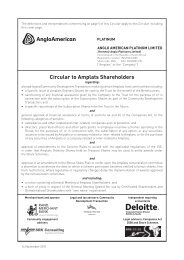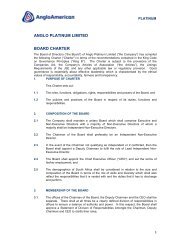Download PDF - Anglo American Platinum
Download PDF - Anglo American Platinum
Download PDF - Anglo American Platinum
Create successful ePaper yourself
Turn your PDF publications into a flip-book with our unique Google optimized e-Paper software.
After the formation and early progress of the Task Team, theresettlement process recommenced. However, a faction within theMDC broke away from the group, forming another resistance group:the Motlhotlo Relocation Resistance Committee (MRRC). The MRRCclaim they formed in protest against the compromises the MDCwere making on behalf of the community since joining the TaskTeam.One hundred percent vacant occupation has not been secured atold Motlhotlo. Sixty four houses still remain; these are represented bythe MRRC. These households cannot be evicted until such time thatthe DLA ( 1 ) awards AP with their surface lease agreement for this land.The provincial DLA are, however, withholding this lease agreement.This is because the DLA is not happy with the S21’s being a lessor(‘middleman’) as originally contemplated during the former MinisterDidiza’s term. Instead, they want the direct leases with themselvesas owners of Overysel Farm and with MTA as owner of SwartfonteinFarm. To this end, engagement with all stakeholders is underwaythrough a task team led by the Department of Mineral Resourcesand the DLA. In the interim, AP has submitted their applicationfor the surface lease agreement with the national DLA. AP is stillawaiting their response.In the interim, the village construction was completed in December2008, and 893 households were relocated. Albeit that not allhouseholds have moved, AP considers that all its commitmentsin terms of the relocation agreements have been met – with theexception of some outstanding grievances associated with thehomesteads, infrastructure and services at the new site. The majorityof these were due to have been addressed by mid December 2009.Given the ineffectiveness of the sanitation system (Enviro-loos), APhas committed to providing an alternative solution in the form oflined Ventilation Improved Pots (VIPs) s in each homestead, at AP’sadditional cost. This is due to be rolled out in early 2010.AP is currently awaiting hand-over of services to the MogalakwenaMunicipality.In parallel to the above, the S21s have recently been dissolved,and consultation on an alternative structure is currently underway.It is conceived that this alternative structure will be the vehiclethrough which AP will engage the communities during the postresettlementphase, and administer the R25 million developmentfund per community.The leases (surface rights) are currently being renegotiated directlywith the landowners being Government (DLA) and the MTA to theexclusion of the erstwhile representative bodies (S21’s).1 Now Department of Rural Development or DRDB.3 Overview of Key Strengths andWeaknesses in the MotlhotloResettlement ProcessThis section provides an overview of key strengths and weaknessescharacterising the Motlhotlo resettlement process, as identifiedthrough ERM’s resettlement review. These cover a range of topics,although strengths and weaknesses relating to the consultationprocess are discussed separately in Section B.3.3.B.3.1 Key StrengthsThe greatest strength of the Motlhotlo resettlement process lies inthe ‘physical aspects’ of the resettlement process. This is reflected, inparticular, in the success of their overall approach to:• household audits and valuation of assets;• compensation for loss of assets;• grievance procedure put in place for compensationand household defects;• overall quality of the replacement houses;• key aspects of service provision;• physical support provided during the actual move;and• security of tenure for the new homesteads.Successes in these areas would seem to draw on AP’s internaltechnical capacity to coordinate and manage large scale projects.These key strengths are elaborated on below.Inventory and Valuation of AssetsOn the whole, the inventory and valuation of assets at Motlhotloappears to have been well implemented and show considerableeffort towards implementing the lessons learnt at Ga Pila. Interms of IFC Performance Standard 5, AP met the requirement ofimplementing an audit of all affected households. A comprehensiveauditing process was undertaken to ensure all assets were measured,including trees, crops and external structures.One could deduce that the benefit of the efforts put into the auditprocess is reflected in the fact that 100 percent of homeownerssigned off on the audit results. This includes key individuals who laterchanged their minds about relocating. It should, however, be notedthat concerns have subsequently been raised regarding the extentto which residents fully understood what they were signing. Thisissue is discussed in more detail later in Section B.3.2.iii



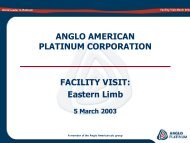
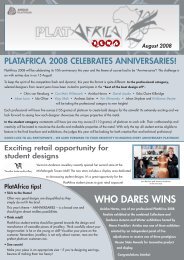
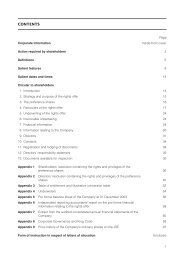

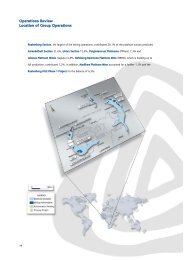



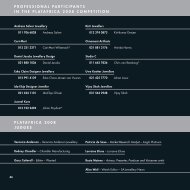
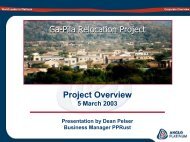

![[PDF] Mogalakwena Mine - Anglo Platinum](https://img.yumpu.com/43065142/1/184x260/pdf-mogalakwena-mine-anglo-platinum.jpg?quality=85)
